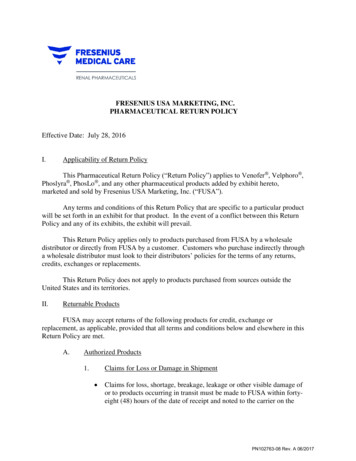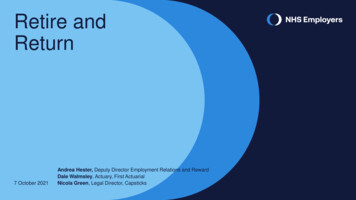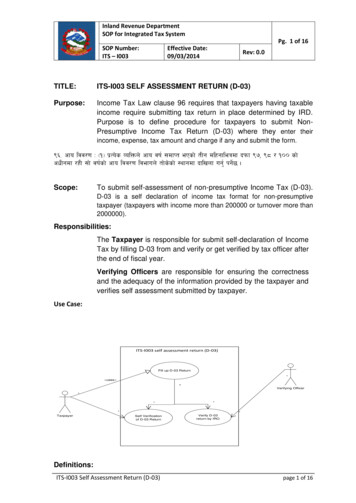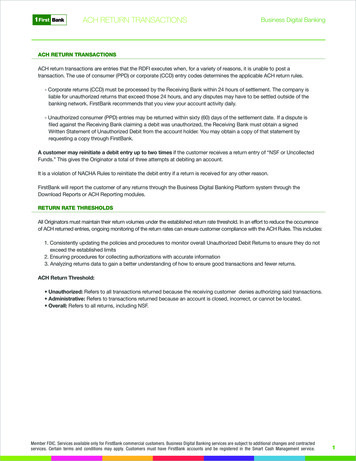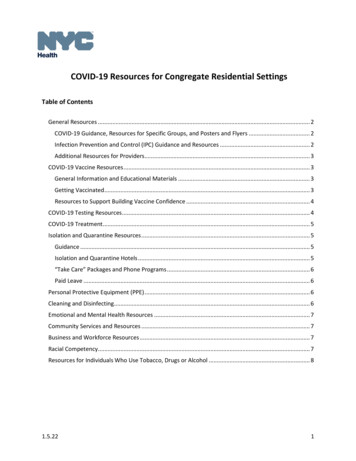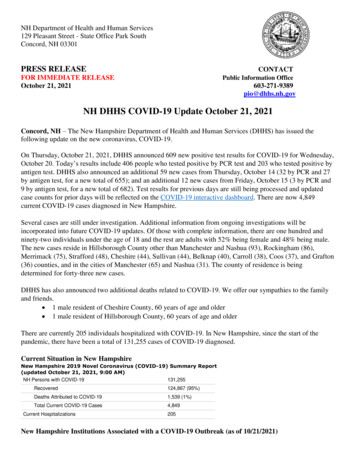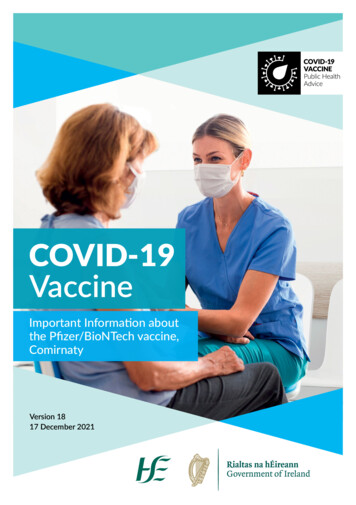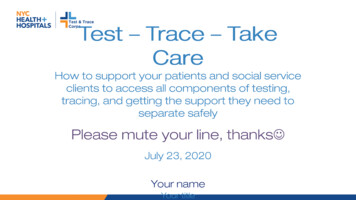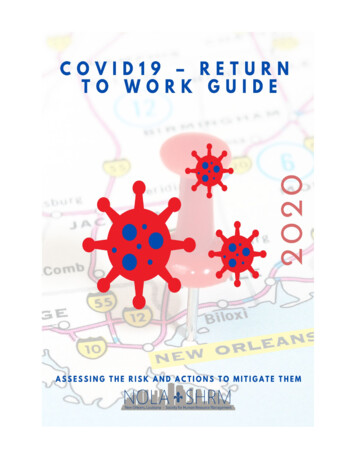
Transcription
ContentsReturn to Work Guide – Assessing the Risk and Actions to Mitigate Them . 2Consider establishing a COVID-19 Response Team . 4 Sample COVID-19 Crisis Team Roles & Responsibilities . 4Develop communications that inform the employees of their return to work status. . 5 Why Must I return? . 5 How Safe is the Workspace going to be?. 5Prepare the Facility . 6Cleaning the Facility: . 6 Facilitating Social Distancing by design:. 6 Screening Stations:. 6Links to Tools and Resources: . 6Establish a COVID-19 Prevention Plan . 8 Prevention Equipment and Supplies . 8 Return to Work Training for Returning Employees . 8 Return to Work Schedules . 8 Employee Screening Protocols: . 8 Social Distancing Policy . 8 How to Handle Workplace Detected Illnesses . 8 Return to Work After Illness . 9 Visitors and Vendors . 9 Handling Mail . 9 OSHA and CDC tools and resources on their website . 9SAMPLE Disinfectant Supplies List . 9SAMPLE Disinfection Protocols . 10Prepare for the Psychology of Return to Work. 11 Links to Tools and Resources . 11Understand the Employment Law Related to Return to Work. . 12 Links to Tools and Resources: . 12Conclusion . 13NOLA SHRM Return to Work Guide 5.20201
Return to Work Guide – Assessing the Risk and Actions to Mitigate ThemThis document is designed to provide a framework for preparing a company to return employees to workfollowing the pandemic. We will all continue to navigate and learn within the landscape of COVID-19.Our hope is that this resource helps your organization prepare for returning employees in a manner theyfeel comfortable performing their jobs safely.Returning to work should be something that the leadership team carefully evaluates and decides. Underthe circumstances today, this decision is layered with complexity and should not be taken lightly.Several questions the leadership team should have clarity on: Is the business prepared to take the necessary precautions to protect the employees?Is there a financial need or outcome to deliver that is best met if employees return now?What’s working or not working with telework/remote work as it is today?Is the office ready to be re-inhabited? Was it deep cleaned?Can the business/leaders reassure employees that they will be safe entering the workspace?Is it mandatory to return to the office full time?Will telework be allowed for those employees who continue to have constraints for childcare?Which departments need to return to the workspace and why?Will the company provide training on how to maintain a safe workspace?Is the business prepared to conduct screenings and protect confidential employee information?What happens if employees come back to work and get sick?NOLA SHRM Return to Work Guide 5.20202
Once the decision is made to bring employees back to work, here are some things to consider or put inplace: Consider establishing a COVID-19 Response Team. Depending on the size of your company,ensure that you have an appropriate representation from all key levels. If your company hasseparate divisions or brands with different leaders assigned, make sure to include leaders fromevery part of the business. Develop communications that inform the employees of their return to work status. It issuggested to follow the communication process used when closing the office to reopen it. Thecommunication plans should not only inform of the business expectations, it must state terms ofemployment and compensation for each employee. The communication should include stepsbeing taken by the company to ensure employee safety. Prepare the Facility. Whether you own or rent your office space, the responsibility to ensure theworkspace is safe is on the business owner and leadership team. Work with experts who canreassure you that a deep clean has been done and you have eliminated Sick Building Syndromefrom your list of concerns. OSHA and CDC have guidelines and resources to assist in this area. Establish a COVID-19 Prevention Plan. This plan should entail all the protocols, tools andresources that will be in effect within your company/office to prevent and manage COVID-19.Execution of this plan should reassure your employees you have thought through their return towork plan. Elements of this plan should include onsite temperature checks, return to worktraining and training on all the COVID-19 safety protocols, access to preventative supplies andresources and written how-to do procedures. The plan should be designed so that everyemployee understands their responsibilities for prevention and the implications for not takingprevention seriously. Prepare for the Psychology of Return to Work. Returning to work may be an escape from thechallenges of home life for some employees, but not all employees will be happy orcomfortable. Many employees will be dealing with residual affects from this pandemic.Challenges and anxiety may be related to their own preexisting conditions being in anuncontrollable workspace with other colleagues, challenges related to caring for other familymembers, financial implications of layoffs, furloughs, or salary reductions. Establish EAP optionsfor employees to seek and get help if needed. Understand the Employment Laws related to Return to Work. FMLA, Expanded FMLA,Emergency Paid Sick Leave, OSHA, DOL, Labor Relations Board, EEOC, etc., will all be at play inyour return to work transition. Be informed and advised on what rules, laws or regulations areat play for the decisions being made at every level of the organization. One leader’s decision canset off a chain of unfavorable events and place a company in a PR or legal mess.NOLA SHRM Return to Work Guide 5.20203
Consider establishing a COVID-19 Response TeamYour COVID-19 Response Team should be comprised of a diverse group of the best and the brightestwithin your company. It also should provide opportunity for each member to expresstheir opinions without fear. The Team should have an executive sponsor, someonewith spending and decision-making authority.Team members included should understand the risk and be capable of devising aplan of action to minimize the risk to the company. This team should also be giventhe authority and means to do the work necessary. Sample COVID-19 Crisis Team Roles & ResponsibilitiesSite Manager – Site manager who has overall responsibility for the site’s pandemicpreparedness & response plan, coordinating and aligning with Executive Team Member orOwner. This role is on the COVID-19 Crisis Team.Managers and Team Leads – Works with the Site Manager to manage social distancing logisticsin regard to arriving and departing employees, as well as visitors and contractors. Will furthersupport the Virus Prevention & Protocol leader by providing site specific options regarding socialdistancing within the workspace, including potential mitigation measures to manage risk ofemployees required to work 6-feet from others.Virus Prevention & Protocols Lead – Works to develop protocols to ensure the wellness of allemployees and the overall pandemic preparedness and response plan, ensuring alignment withcompany protocols and the COVID-19 Crisis Team.Sanitization & Disinfection Lead – Works to manage daily and periodic disinfection logistics,including routine and deep cleaning, disinfection processes in accordance to the protocols setup by the Virus Prevention & Protocol leader. Drives process continuous improvement of theprocesses and ensures 100% compliance of the disinfection protocol and any approved regionalor site variations.Communication & Training Lead – Works to manage all pandemic related communications inaccordance with Communications and HR departments (if applicable). Manages the trainingfunction across the company related to pandemic preparedness and response, including bothemployee, management and pandemic response team training in accordance with yourplaybook and COVID-19 Crisis Team’s directive.PPE & Materials Lead – Works to secure all necessary supplies to implement and sustain the sitepandemic preparedness and response plan. If your company has multiple locations, considercoordination of procurement; direct procurement by each location vs. coordination withprocurement department or a central control person to manage inventory and purchasesupplies. Leverage buying power for supplies from vendors.Depending on your business you may need to combine, eliminate or add roles that are deemed criticalto your plan. Treat this like all other strategic plans, get the right people in the right seat on your bus!NOLA SHRM Return to Work Guide 5.20204
Develop communications that inform the employees of their return to work status.HR and key decision makers should use the same systems and processes that were used during the workreduction. With all the uncertainty and anxiety related to COVID-19, we suggest consistency. If yourstyle of communicating with employees worked well for the layoffs and furloughs, then maintain thatstyle for the return. Where there are areas for improvement, please take the time to tweak, howeverradical changes may cause your employees and some leaders to be confused or skeptical. Why Must I return?In preparation for communicating with employees, key stakeholders should work through some of thefollowing: Consider what is needed from the employees returning to the workspace.Consider who is returning to work.What is the employee’s status: Layoff, furlough, re-assignment?Will telework be an option? If so, who decides?When they return, what will be the terms of their work relationship?Think of the Return to Work as a new hire or rehire process. Communicate with the employees todemonstrate you are offering comfort and stability. Address questions related to salary, benefits, worklocation, requirements, and if applicable discuss flex schedules.Word of caution: Parents and caregivers may have some anxiety related to day care or care supportsystems. Where possible, we suggest being flexible and negotiate returns based on the needs of theemployee and the business. Under the circumstances, rigid, one size return to work stances or policiesmay result in a drop in engagement or cause resignations. How Safe is the Workspace going to be?The second critical part of the communication plan should be focused on safety of the workspace. Wesuggest that you conduct return to work meetings or trainings to share parts of the return to work planwith them. Here are some items you may want to share: Building preparation and ongoing disinfection procedures.Safety Training: social distancing procedures, sanitation, handwashing, etc.Daily or self-testing procedures if applicableEmployee Assistance offerings if applicableRemember, for the past weeks since the office closed, managers have been working to increaseproductivity through remote and telework scenarios. Return to work is another change, that eachmanager and team will have to adjust to. This change will impact productivity and outcomes.NOLA SHRM Return to Work Guide 5.20205
Prepare the FacilityIf your company had any employees who were confirmed positive for COVID-19,there will be some concerns within the employee population regarding the safetyof your facility or office. If you lease a space and you have employees who youare requiring to return to work, do your diligence to understand the cleaningprotocol for the building and share that with employees. Cleaning the Facility:The CDC and OSHA have tools and resources available to assist you with understanding safe protocolsfor deep cleaning and disinfecting the facility. The CDC has a section on their website with signs for yourworkspace that are designated to help you with communicating certain elements of COVID-19 to youremployees. These can be posted and used throughout the facility/workspaces. https://www.cdc.gov/ Facilitating Social Distancing by design:Your COVID-19 team should examine the workspaces and devise ground rules on Social Distancing as weunderstand it. This entails establishing how many people can assemble in the various workspaces in yourfacility and comply with social distancing rules. This may mean posting signs in conference rooms or break areas regarding capacity allowed orclosing areas that employees congregate; coffee pot, refrigerator, tables/chairs, etc.May require repositioning furniture or work areas to facilitate social distancing.May require construction of barriers to establish separation between workstations. Screening Stations:Your COVID-19 team should examine the protocols that have been established by theCDC and OSHA to develop the company’s facility/office screening. Please note this isan area of planning that should involve a cross-functional team to be clear on theprocesses. If you do not have a cross-functional team, we advise reviewing your planwith legal counsel.Things to consider; this is not an exhaustive list, just one to get the team thinkingthrough the volume of risks and responsibilities involved: Review the various guidelines in play: HIPAA, ADA, OSHA, local fire codes, etc.Where will the screening be setup?Will there be a screening checkpoint?Is there a way physically to get around the screening protocol, 2nd entrance with no screening?Who is in charge each day? How long is the station staffed to ensure compliance?What training does the staff need to perform the screenings?What authority do they have to address any compliance issues?Has everyone returning to work been informed of the screening process?Finally, the work done in this area must be treated as extremely sensitive, private, and confidential ifdone by employees verses a hired third party. A third-party contractor must commit to and be able todemonstrate the sensitivity, privacy and confidentiality required.Links to Tools and Resources: ign/NOLA SHRM Return to Work Guide 5.20206
SAMPLE Office Opening Protocols#Topic1COVID-19 Response Team (CRT)2Preventative Material Inventory3Personal Protective Equipment4Disinfection Measures5Deep-Cleaning and DisinfectionProtocol6Inbound Parts/Materials/Packages7Audit Checklists/Compliance Tools8Isolation Protocol & Training9Social Distancing Protocol10On-Site Health Screening11 Daily Self-Screening Protocol12 Self-Quarantining and Return toWork ProtocolTask Set up the COVID-19 Response Team (CRT) Have a plan in place to adopt this corporate framework and develop sitespecific/office location protocols Confirm adequate supply of soap, disinfectant, hand sanitizer, paper towelsand tissues are on site and available when needed Confirm stock of face coverings; masks and/or face shields, gloves, and glasseson-site and on order with lead time, if necessary Have “touchless” thermometers on-site for employee screening Continue to monitor CDC and OSHA for updates to guidelines Review and understand protocol Monitor the CDC and OSHA for guidelinesDisinfect facility/workspaces prior to anyone returning to workReplace HVAC air filters or clean/disinfectImplement the General Disinfection ProceduresReview, understand, and prepare for the implementation of the Deep-Cleaningand Disinfection Protocol for your business and/or office Check with building landlord to inquire on their protocols Manage incoming supplies in accordance with OSHA/CDC standards Monitor CDC for package handling procedures Develop checklist for critical areas to monitor and ensure compliance tostandards Communicate and adhere to consequences for lack of compliance Review and understand CDC protocol Protocol in place to isolate employees if symptomatic on site Print out incident reporting forms and protocol to be available as needed Proper tracking and reporting according to OSHA standards Review and understand social distancing protocol Monitor and continue to adhere to the Social Distancing Ensure protocol for pre-shift screening prior to facility/office entry points Ensure barriers are in place to prevent anyone from avoiding screeningprotocols Ensure that all employees are screened to avoid discrimination issues Daily Self-Screening protocol is distributed to all employees for voluntary,home self-screening HR team and leaders are trained to receive inquiries or reports of symptomaticemployees prior to shift and what to do if symptomatic Review and understand protocol and adjust as necessary for local, legal andcultural environmentVisitors & Contractors Self-Screening 14Employee Trainings Health & Wellness 15 13Plan in place for screening Visitors and ContractorsVisitors & Contractor Self-Screening Checklist printed and available as neededHost Pre-Return to Work Trainings:Review of Safe Work Playbook with all employeesTraining for Health Screeners & Isolation CoordinatorsTraining for Disinfection Team & HR Team Host First Day Trainings/OrientationLocalize playbook presentation & materials to be consistent with facility/officeHost first-day training orientation for all returning staff and executivesSelf-Screening ChecklistHealth & Wellness Videos from CDC or other agencies if applicableNOLA SHRM Return to Work Guide 5.20207
Establish a COVID-19 Prevention PlanOnce you’ve decided it is critical to your business to have employees return to work, the task becomeshow to keep them healthy. Handwashing, fever, coughing, temperature checks are now a part of oureveryday language. These things will more than likely be a part of your company and office culture forthe foreseeable future. Here are a few items that can assist you with prevention: Prevention Equipment and Supplies: You will not be able to prevent if you do not have theright tools and resources. We have included several sample lists throughout this guide that mayassist you with developing your prevention plan.Return to Work Training for Returning Employees: Maybe call it COVID-19 Orientation, butthis should be the opportunity the company takes with every returning employee to explain therules of engagement while under the COVID-19 Pandemic.Return to Work Schedules: This is about arrival times and departures times to preserve socialdistancing protocols.o If your office operated on a flexible work schedule or allowed employees to arrive anddepart at will, you will have to consider what happens when several employees arrive atthe same time.o Do they wait in line for prescreening?Employee Screening Protocols: Lay out the what, when, andhow of daily screening. Also include the implications for notfollowing these protocols.o Daily Employer Screenings: Whatever is in place must be consistentlyfollowed by everyone, including owners andsenior leaders or it will fall apart quickly and riskyour intended goal of preventing an outbreak in your office. Where will the screening be setup? Will there be a screening checkpoint? Isthere a way physically to get around the screening protocol, 2nd entrance withno screening? Consider the logistics of getting ample supplies to handle the daily volume ofscreenings needed to safely operate your office. Work to establish reliablesources of supplies and equipment. PRIVACY and confidentiality is a must. Seek Counsel on how to handle recordsare kept, how to communicate with employees who are symptomatic andprivacy in general.o Employee Self-Screenings: If possible, establish protocol for self-screening. This could allow for earlydetection and reporting.Social Distancing Policy: Employees returning to work should beinformed of the new guidelines to achieve social distancing. If doneproperly, the facility/workspace will look different than before COVID19. The company should establish a policy on what is social distancingand how to respect social distancing at all times.How to Handle Workplace Detected Illnesses: What if your employeescreening protocol detects an employee with high temp? What will bethe company’s protocol on how to direct that employee? What is theprocess to ensure that employee is cleared to return to work?NOLA SHRM Return to Work Guide 5.20208
Return to Work After Illness: The CDC has guidelines for returning to work after a positiveCOVID-19 test. Review the guidelines and then establish your company protocol. Many peoplewho have positive COVID-19 test are confused about when to start counting the quarantineperiod and the number of healthy days after the quarantine period. Your return plan should becommunicated in a way to clarify these rules and assist the employees with compliance.Visitors and Vendors: Everyone who enters your office or workspace is a challenge to yourprevention plan. Depending on your facility/office layout for deliveries you should establish andpost the COVID-19 protocol for visitors and vendors in a visible location.Handling Mail: The CDC has a statement regarding transmission of COVID-19 by mail. They alsohave guidelines on how to handle mail coming into your office.OSHA and CDC tools and resources on their website: We have included several links to toolsand resourceso s/2019-ncov-factsheet.pdfo y/guidance-businessresponse.htmlo https://www.osha.gov/Publications/OSHA3990.pdfo https://www.osha.gov/dts/osta/otm/otm iii/otm iii 2.html#2o LE Disinfectant Supplies ListItemSpecQuantity1 Mask (surgical)2 Nitrile gloves3 Infrared thermometer4 Disinfectant spray/wipes5 Spray bottles6 Sanitization floor stand7 Hand sanitizer (refills)8 Hand soap9 Paper towels10 Glasses/face shields11 Bio-hazard container12 Clorox Total 360 (optional)NOLA SHRM Return to Work Guide 5.20209
SAMPLE Disinfection Protocols#123Area/PlaceDisinfection ContentWork cell commonsurfacesDisinfection MethodFrequencyIncluding controlbuttons, tools, andother commonsurfacesSpray with handheldsprayer or wipeMinimum at the endof each shiftOffices, desk, andconference roomsComputers, monitorsand accessoriesTable and chairsurfaceWipe areas ofcommon employeecontactSpray with handheldsprayer or wipeSpray with sprayerMinimum at the endof each shiftAt least oncerespectively in themorning andafternoonMoveable trays orcontainersHandles and othercommonly touchedareasSpray with sprayerBased on use; Onceper shift if contactedby 1 person only;otherwise, betweenusersSpray with handheldsprayer or wipeAt least four times perdaySpray with sprayerGenerally, 3 or moretimes per shift toinclude after all breaksand mealsSpray with sprayerGenerally, 3 or moretimes per shift toinclude after all breaksand meals4567General objects often Doors and windows,handles, faucets,used or touchedsinks, and bathroomsWork cell commonsurfacesIncluding controlbuttons, tools andother commonsurfacesEmployee break and Disinfection of tables,chairs, tabletop itemsmealDisinfectantHospital gradedisinfectant or fresh10% chlorine bleachsolution(sodium hypochloritesolution), asappropriateHospital gradeContact surfaces (pay,Spray with sprayerdisinfectant or freshselection and vending10% chlorine bleach8surfaces)solutionCompany vehiclesCommon surfaces (e.g.Spray with sprayer(sodium hypochloriteseat surfaces rails,9solution), asbelts, door andappropriatewindow controls)10 Multi-user safety vest All surfacesSpray with sprayerand other PPEAll floors and wallsAll general floors andMopwalls at siteVending machines11NOLA SHRM Return to Work Guide 5.2020DailyAfter each useBetween usePeriodic, wherefrequently touched;mop hard surfacesdaily10
Prepare for the Psychology of Return to Work.We are starting to hear terms like post-traumatic stress and post-traumaticgrowth, desire for more family time and connection with kids, stress of finding aquality work environment at home. These concerns are in addition to the financialchallenges and worries about debt. It is clear we will need to rethink the return towork and in what psychological shape will employees return? Daily routine of lifechanged dramatically with stay at home orders, people are handling it in differentways. Employers should be prepared to be flexible in taking care of theiremployee’s psychological needs.A healthy part of a company’s return to work plan should include mental and physical health. Considerthe following in your plan: Employee Assistance program. Many companies have these plans in place for certain levels ofemployees. Consider expanding to all employees.Are there local social or religious organizations in the city that have counseling servicesavailable? Post a list of the locations along with contact information in common areas foremployees to engage. If possible, post on a company intranet or communication board.Contact the company’s Broker to get marketing materials for the resources available throughthe company benefits plan.Links to Tools and Resources -helplineNOLA SHRM Return to Work Guide 5.202011
Understand the Employment Law Related to Return to Work.We have mentioned seeking advice from Legal Counsel on several occasions throughout this guide. Thisarea is one where Legal Counsel and a certified human resources professionalcan be invaluable. There are numerous online sources available for “do ityourselfers”, however experience and knowledge of laws and regulations will goa long way in helping your company create a great culture.First step is understanding the federal, state, and local labor laws and thencreating company policies to ensure leaders and employees understand eachother’s rights. COVID-19 will take companies and employees into new spaces ofconflict that could lend themselves to lawsuits. Your team’s job is to get to work understanding thecurrent laws and employee rights, then make the adjustments to adapt to the challenges resulting fromCOVID-19. Like everything else in this guide, assess and consider the following: What is the plan for return to work? Is it mandatory or optional?Who makes the decisions about whether it is optional or not? What are the criteria?Can telework continue?o In which departments or teams?o Who decides this?o What input the employee have in the process?o Are there clear outcomes/KPIs to measure performance?What happens if an employee is afraid and does not want to return to the office?How does the Employer assure employers the facility is safe to work in?Will the employer provide PPE? Is it mandatory to wear face mask while at work? In meetings?To say the least, Employers will have a much bigger and challenging role in protecting employees. Therole should not be taken lightly, especially if the employer mandates a return to work. Links to Tools and Resources: /FFCRA Poster WH1422 LA SHRM Return to Work Guide 5.202012
ConclusionThis Return to Work Guide is just that, a g
NOLA SHRM Return to Work Guide 5.2020 2 . Return to Work Guide - Assessing the Risk and Actions to Mitigate Them . This document is designed to provide a framework for preparing a company to return employees to work

